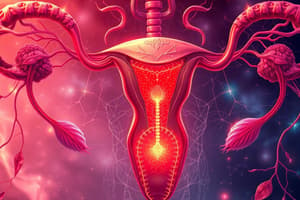Podcast
Questions and Answers
What are ovaries?
What are ovaries?
Glands that produce the egg cells and hormones.
Define fallopian tubes.
Define fallopian tubes.
Tubes which carry eggs from the ovaries to the uterus and which provide the place where fertilization occurs.
What is estrogen?
What is estrogen?
Female sex hormone
What is testosterone?
What is testosterone?
What is the prostate gland?
What is the prostate gland?
What is a fetus?
What is a fetus?
Define semen.
Define semen.
What is fertilization?
What is fertilization?
What happens during an erection?
What happens during an erection?
What are egg cells?
What are egg cells?
What is the cervix?
What is the cervix?
What do seminal vesicles do?
What do seminal vesicles do?
What is the vas deferens?
What is the vas deferens?
What is ejaculation?
What is ejaculation?
What is puberty?
What is puberty?
What is the scrotum?
What is the scrotum?
What is the vagina?
What is the vagina?
What is an embryo?
What is an embryo?
What is the epididymis?
What is the epididymis?
What is the Urethra?
What is the Urethra?
What is the clitoris?
What is the clitoris?
What is the umbilical cord?
What is the umbilical cord?
What is the amniotic sac?
What is the amniotic sac?
What is amniotic fluid?
What is amniotic fluid?
What happens during dilation in labor?
What happens during dilation in labor?
What happens during expulsion in labor?
What happens during expulsion in labor?
Describe placental labor.
Describe placental labor.
Define dilation.
Define dilation.
What is an episiotomy?
What is an episiotomy?
What is afterbirth?
What is afterbirth?
What is the first trimester?
What is the first trimester?
What is the second trimester?
What is the second trimester?
What is menstruation?
What is menstruation?
What is an identical twin?
What is an identical twin?
What is a fraternal twin?
What is a fraternal twin?
What is fimbria?
What is fimbria?
What is cowper's gland?
What is cowper's gland?
What is the foreskin?
What is the foreskin?
What is circumcision?
What is circumcision?
Why we have pubic hair?
Why we have pubic hair?
Flashcards
Ovaries
Ovaries
Glands that produce egg cells and female hormones.
Fallopian Tubes
Fallopian Tubes
Tubes carrying eggs from ovaries to uterus; fertilization happens here.
Labia
Labia
Folds of skin protecting the entrance to the vagina.
Estrogen
Estrogen
Signup and view all the flashcards
Testosterone
Testosterone
Signup and view all the flashcards
Prostate Gland
Prostate Gland
Signup and view all the flashcards
Fetus
Fetus
Signup and view all the flashcards
Semen
Semen
Signup and view all the flashcards
Fertilization
Fertilization
Signup and view all the flashcards
Erection
Erection
Signup and view all the flashcards
Egg Cells
Egg Cells
Signup and view all the flashcards
Cervix
Cervix
Signup and view all the flashcards
Seminal Vesicles
Seminal Vesicles
Signup and view all the flashcards
Testes
Testes
Signup and view all the flashcards
Vas Deferens
Vas Deferens
Signup and view all the flashcards
Ejaculation
Ejaculation
Signup and view all the flashcards
Puberty
Puberty
Signup and view all the flashcards
Scrotum
Scrotum
Signup and view all the flashcards
Vagina
Vagina
Signup and view all the flashcards
Embryo
Embryo
Signup and view all the flashcards
Uterus
Uterus
Signup and view all the flashcards
Epididymis
Epididymis
Signup and view all the flashcards
Urethra
Urethra
Signup and view all the flashcards
Clitoris
Clitoris
Signup and view all the flashcards
Sperm Cells
Sperm Cells
Signup and view all the flashcards
Placenta
Placenta
Signup and view all the flashcards
Umbilical Cord
Umbilical Cord
Signup and view all the flashcards
Amniotic Sac
Amniotic Sac
Signup and view all the flashcards
Amniotic Fluid
Amniotic Fluid
Signup and view all the flashcards
Menstruation
Menstruation
Signup and view all the flashcards
Study Notes
- Study notes on sex ed, grade 8
Female Reproductive System
- Ovaries are glands that produce egg cells and estrogen.
- Fallopian tubes transport eggs from the ovaries to the uterus; fertilization occurs here.
- Labia are the folds of skin located on the outside of the vagina.
- Estrogen is the primary female sex hormone.
- Egg cells are produced in the ovaries.
- The cervix is the opening to the uterus.
- The vagina is the female sex organ and serves as the birth canal.
- The uterus houses the fetus during pregnancy.
- The clitoris is erectile tissue located between the labia.
- Progesterone is a hormone produced by the ovaries that works with estrogen to regulate the menstrual cycle.
- Fimbria are finger-like projections at the end of the uterine tube, guiding eggs into the fallopian tube.
- The hymen is a membrane fold near the vaginal opening.
- The perineum is skin located between the anus and vagina that protect the membrane.
Male Reproductive System
- Testosterone is the primary male sex hormone.
- The prostate gland adds chemical fluid to the semen.
- Semen is the fluid ejaculated from the penis.
- Testes are the organs that produce sperm.
- The vas deferens is a tube that carries sperm from the testes.
- Ejaculation happens when semen leaves the penis.
- The epididymis is where sperm fully mature and are stored.
- The urethra is the tube that carries urine from the bladder to outside the body.
- Sperm cells are produced in the testes.
- Seminal vesicles add a sugary (alkaline) fluid to semen.
- Cowper's gland consists of two small glands on each side of the urethra, adding lubricating/cleaning fluid to sperm.
- The scrotum is a sac that regulates the temperature of the testes.
- An erection occurs when blood rushes to the penis, causing it to become engorged and hard.
- Foreskin is a skin covering the penile glans.
- Circumcision is the surgical removal of the foreskin.
Pregnancy and Development
- Fertilization occurs when a sperm cell joins an egg cell.
- The embryo describes the first two months of development in the uterus.
- The fetus describes the last 7 months of prenatal development.
- The placenta nourishes the fetus with the mother's blood supply.
- The umbilical cord is a flexible cord containing blood vessels connecting the fetus to the placenta.
- The amniotic sac is a thin sac in which the fetus develops.
- Amniotic fluid inside the amniotic sac regulates fetal temperature and provides cushion and protection.
Labor and Delivery
- Dilation (labor) is the first stage of labor, with contractions and the cervix thinning out and dilating.
- Expulsion is the second stage of labor, from full dilation to the birth of the baby.
- Placental is the third stage of labor when the placenta separates from the uterine wall, ending with the placenta's delivery.
- Dilation is the gradual opening of the cervix in preparation for delivery.
- Episiotomy is a surgical cut made from the vagina to the anus to ease the baby's passage.
- Afterbirth refers to the placenta after it has been delivered.
Pregnancy Stages
- The first trimester lasts from 0-13 weeks and is most crucial for the baby’s development; most miscarriages happen during this time.
- The second trimester lasts from 14-26 weeks and the baby begins to move and kick.
- The third trimester is the final stage of pregnancy.
Other Terms
- Puberty is the period of sexual maturation, usually starting around 12 or 13.
- Menstruation is the process where the uterine lining is shed with a small amount of blood.
- Identical twins develop from one fertilized egg that divides.
- Fraternal twins develop from separate fertilized eggs.
- Fraternal twins can also occur from two separate eggs and two separate sperm cells.
- Pubic hair is hair on genitals meant to trap debris.
- The rectum is the final section of the large intestine that stores waste.
Studying That Suits You
Use AI to generate personalized quizzes and flashcards to suit your learning preferences.




